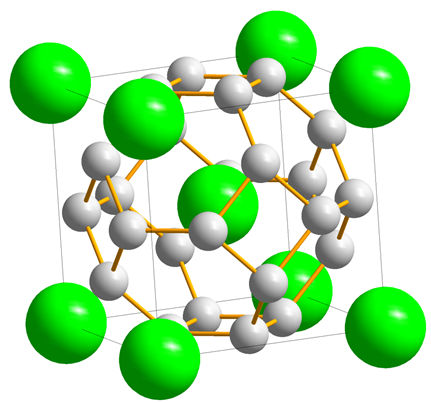ratings
In this course, we will discuss the complete chapter named Solid State Chemistry of Class 12 Chemistry. we will discuss each and every topic important from the CBSE point of view. This course is designed in a very easy to understand format using 3D visual animations which boost your learning and help you understand and visualize difficult topics easily
1 week, 1 day
May 17, 2021
8
8 hours
In this course, we will discuss complete chapter named Solid State Chemistry of Class 12 Chemistry. we will discuss each and every topic important from CBSE point of view. This course is designed in a very easy to understand format using 3D visual animations which boost your learning and help you understand and visualize difficult topics easily
INTRODUCTION:
Three states of matter are solid, liquid and gas. Amongst them liquid and gases are called fluids because of their ability to flow. But solid cannot flow. The reason for that is particles in solid are not free to move in available space. There is strong intermolecular force of attraction in between the particles in solid. The constituents particles in solid have fixed position and can only oscillate about their mean position. This gives the rigidity to the solid and hence a fixed shape also. In brief we can say that:
“Solid state of matter possesses fixed mass, volume, shape and rigidity “.
Solids are classified on the basis of arrangement of constituent particles. Due to their specific arrangements, it shows wide range of properties and hence varied applications like as superconductors, magnetic materials, polymers etc.
GENERAL CHARACTERISTICS OF SOLID STATE:
In nature the particular state of matter is governed by two opposing forces at given set of temperature and pressure. These forces are intermolecular force of attraction and thermal energy. If intermolecular force of attraction is high as compared to thermal energy, particles remains in closest position and hence very less movement in particles is observed. In this case solid state is the preferred state of matter.
Let us revise the general characteristics of solid:
i) Fixed mass, volume and shape
ii) Strong intermolecular force of attraction
iii) Least intermolecular space
iv) Fixed position of constituent particles
v) Incompressible and rigid
CLASSIFICATION OF SOLIDS:
Solids are classified on the basis of arrangement of their constituent particles. If the arrangement of constituent particles is same throughout the solid (long range order) it is called crystalline. If the arrangement of particles does not follow any regular pattern throughout the solid (short range order) it is called amorphous solid.
Characteristics of crystalline solid:
- It consists of large number of small crystals having a definite geometrical shape.
- The arrangement of constituent particles is regular throughout the solid (long range order). That is a fixed pattern of constituent particles repeat itself periodically over the entire range of solid.
- They have sharp melting points.
- They are anisotropic in nature.
Anisotropy is defined as” Difference in properties when measured along different axes or different directions”.
Crystalline solid show different values of some of the physical properties like electrical resistance, refractive index etc.when measured along the different directions. The anisotropy arises due to the different arrangement of particles in different directions.
Characteristics of amorphous solid:
- The arrangement of constituent particles is irregular throughout the solid. Regular pattern of constituent particle is visible in small areas only. That is it shows short-range order.
- Melting point is not sharp. Amorphous solid melts over a range of temperature.
- They have tendency to flow at slower rate.
- They are isotropic in nature.
“Isotropic means no difference in properties taken from any direction.”
Intext Questions:
Q.1 Classify the following solids as crystalline and amorphous.
Sodium chloride, quartz glass, quartz, rubber, polyvinyl chloride, Teflon
A.1 Crystalline solid: Sodium chloride, Quartz
Amorphous solid: Quartz glass, rubber, polyvinyl chloride, Teflon.
Q.2 why glass is considered as super cooled liquid?
A.2 Glass shows the tendency to flow at slower rate like liquid. Hence they considered as super cooled liquid.
Q.3 why the window glass of old buildings show milky appearance with time?
A.3 Glass is an amorphous solid. Amorphous solid has the tendency to develop some crystalline character on heating. Due to heating in day over the number of years, glass acquires some crystalline character and show milky appearance.
Q.4 why the glass panes fixed to window or doors of old building become slightly thicker at bottom?
A.4 Glass is super cooled liquid. It has the tendency to flow down very slowly. Due to this glass pane becomes thicker at the bottom over the time.
Q.5 Sodium chloride is a crystalline solid. It shows the same value of refractive index along all the direction. True/False. Give reason.
A.5 False
Crystalline solid shows anisotropy in properties. That is, it shows different values for the given physical property in different direction. All the crystalline solids show anisotropy in refractive index. Therefore sodium chloride will show different values of refractive index on different directions.
Q.6 Crystalline solid are anisotropic in nature. What does this statement means?[CBSE 2011]
A.6 Anisotropy is defined as” Difference in properties when measured along different axis or from different directions”. Crystalline solid show different values of some of the physical properties like electrical resistance, refractive index etc.when measured along the different directions. The anisotropy in crystalline solid arises due to the different arrangement of particles in different directions.
CLASSIFICATION OF CRYSTALLINE SOLIDS:
Crystalline solid can be classified on the basis constituent particles and intermolecular force of attraction in between them. Constituent particles are molecules, ions, metal kernel in sea of electrons and atoms. Force of attraction operate in between the particles are dispersion force, dipole-dipole interaction, hydrogen bonding, electrostatic attraction, metallic bonding and covalent bonding.
Studens
About Instructor
More Courses by Insturctor
Course Currilcum
- Lecture 1 01:00:00
- Lecture 2 01:00:00
- Lecture 3 01:30:00
- Lecture 4 01:00:00
- Lecture 5 01:00:00
- Lecture 6 FREE 01:30:00
- Lecture 7 01:00:00
- Lecture 8 FREE 01:30:00

